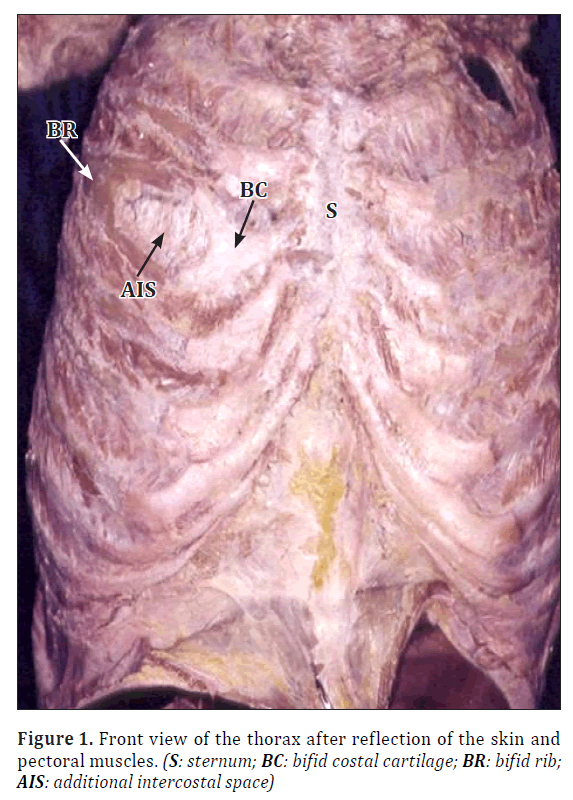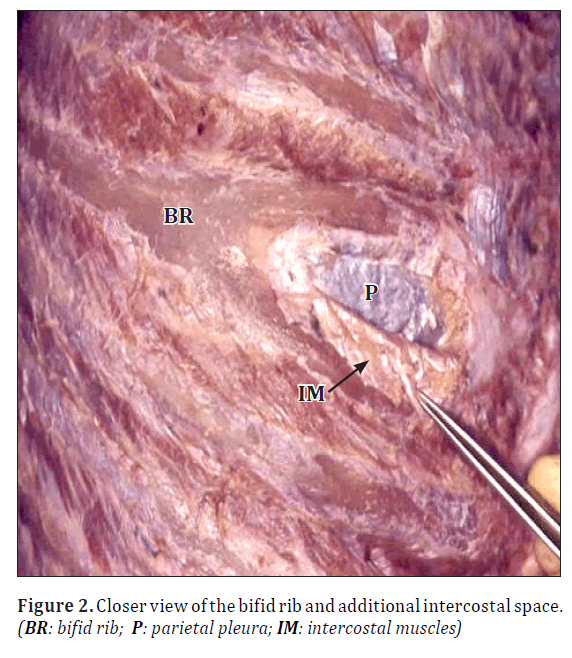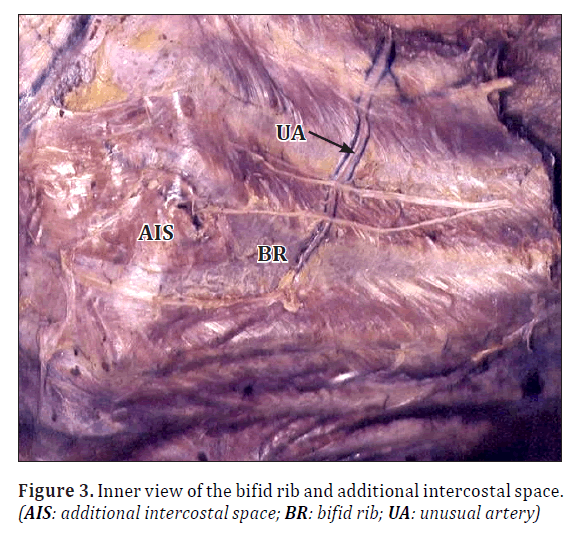A case of bifid rib and additional intercostal space
Satheesha Nayak B*
Department of Anatomy, Melaka Manipal Medical College (Manipal Campus), International Centre for Health Sciences, Manipal University, Madhav Nagar, Manipal, Karnataka, India
- *Corresponding Author:
- Dr. Satheesha Nayak B.
Professor and Head, Department of Anatomy, MMMC Int. Centre for Health Sci. Manipal University, Madhav Nagar, Manipal, Udupi District, Karnataka, 576 104, India
Tel: +91 820 2922519
E-mail: nayaksathish@yahoo.com
Date of Received: January 4th, 2012
Date of Accepted: December 25th, 2012
Published Online: December 25th, 2012
© Int J Anat Var (IJAV). 2012; 5: 128–129.
[ft_below_content] =>Keywords
intercostal space, rib, bifid rib, thorax, variation
Introduction
The thoracic cage is made up of twelve vertebrae, sternum and twelve pairs of ribs. The ribs articulate with the vertebrae posteriorly and with the sternum through the corresponding costal cartilages anteriorly. The spaces between the adjacent ribs are called intercostal spaces. There are 11 intercostal spaces on each side. The intercostal spaces are filled with three layers of intercostal muscles and are also occupied by the intercostal nerves and vessels. It is very rare to see variations of the ribs and intercostal spaces. Knowledge of variations of ribs and intercostal spaces is important for clinicians and radiologists.
Case Report
During routine dissections for medical undergraduates, we observed variations of the rib and intercostal spaces in an adult male cadaver. The right 4th rib bifurcated just anterior to the midaxillary line. The right 4th costal cartilage also bifurcated in a similar manner. The bifurcated ends of the rib and costal cartilage joined with one another to surround an additional intercostal space (Figures 1, 2 and 3). The additional intercostal space was about 8 cm long and had all the three layers of intercostal muscles. The muscles of the space were supplied by the collateral branch from the 3rd intercostal nerve (Figure 3). Further, a medium sized artery originated from the subclavian artery and descended up to the 4th intercostal space, from the inner aspect of the upper three intercostal spaces. This artery ran down just lateral to the additional intercostal space.
Discussion
Congenital variations of the ribs include cervical rib, bifid anterior rib, and fusion of adjacent ribs [1]. Supernumerary intrathoracic [2] and transthoracic ribs [3] have been described previously. Bifurcation of the rib and presence of additional intercostal spaces is a very rare variant of the thorax. Very few cases have been reported on such variations. Song et al., have reported three cases of bifurcation of the right fourth rib [4]. Osawa et al., have reported the presence of bifurcated 3rd and 4th ribs in three cases [5]. In all three cases additional intercostal spaces were observed. Bifid intrathoracic rib is a very rare presentation where a bifid osseous process of the rib projects into the thoracic cavity. Kamano et al., have reported such a case as seen in CT scan [6]. Embryologically, development of intrathoracic rib is uncertain and probably results from an incomplete fusion of cephalic and caudal segments of sclerotome during embryogenesis, occurring around the 4–6th week of fetal life. Intrathoracic rib is usually an isolated finding, but it might be associated with deformities of the vertebral bodies. Intrathoracic rib remains frequently non-symptomatic; but thoracic pain, dyspnea or even hemoptysis have been reported. Pain has been reported in case of its fibrous attachment to the diaphragmatic pleura.
The overall prevalence of bifid rib is estimated at 0.15% to 3.4%, and it accounts for up to 20% of all congenital rib variations [7]. It is usually unilateral. Presence of bifid rib and additional intercostal space as reported here may go unnoticed for years together. But the knowledge of this variation may be of importance for radiologists because it may lead to wrong diagnosis. It might also cause confusions in the counting of the ribs and intercostal spaces for certain surface markings and surgical procedures. The unusual artery crossing the upper three intercostal spaces is a new finding and such a case has not been reported yet. This artery might cause unexpected bleeding in any surgical procedures of the upper thorax.
References
- Steiner HA. Roentgenologic manifestations and clinical symptoms of rib abnormalities. Radiology, 1943; 40: 175–178.
- Freed C. Intrathoracic rib: a case report. S Afr Med J. 1972 Aug 19; 46: 1165–1167.
- Shoop JD. Transthoracic rib. Radiology. 1969; 93: 1335–1336.
- Song WC, Kim SH, Park DK, Koh KS. Bifid rib: anatomical considerations in three cases. Yonsei Med J. 2009; 50: 300–303.
- Osawa T, Sasaki T, Matsumoto Y, Tsukamoto A, Onodera M, Nara E, Chen JK, Fujimura A, Nozaka Y. Bifid ribs observed in the third and the fourth ribs. Kaibogaku Zasshi. 1998; 73: 633–635.
- Kamano H, Ishihama T, Ishihama H, Kubota Y, Tanaka T, Satoh K. Bifid intrathoracic rib: a case report and classification of intrathoracic ribs. Intern Med. 2006; 45: 627–630.
- Charles I, Scott J. Pectoral girdle, spine, ribs, and pelvic girdle. In: Stevenson RE, Hall JG, Goodmann RM, eds. Human Malformations and Related Anomalies. Vol. 2. New York, Oxford University Press. 1993; 655–697.
Satheesha Nayak B*
Department of Anatomy, Melaka Manipal Medical College (Manipal Campus), International Centre for Health Sciences, Manipal University, Madhav Nagar, Manipal, Karnataka, India
- *Corresponding Author:
- Dr. Satheesha Nayak B.
Professor and Head, Department of Anatomy, MMMC Int. Centre for Health Sci. Manipal University, Madhav Nagar, Manipal, Udupi District, Karnataka, 576 104, India
Tel: +91 820 2922519
E-mail: nayaksathish@yahoo.com
Date of Received: January 4th, 2012
Date of Accepted: December 25th, 2012
Published Online: December 25th, 2012
© Int J Anat Var (IJAV). 2012; 5: 128–129.
Abstract
Bifurcation of ribs and presence of additional intercostal spaces is a very rare variation of the thoracic wall. We found a bifurcated right fourth rib during dissection classes. The right fourth costal cartilage also bifurcated and joined the bifurcated rib and created an additional intercostal space. The additional space was about three inches long and had intercostal muscles in it. The muscles of the space were supplied by the collateral branch of the third intercostal nerve. An unusual artery from the subclavian artery ran across the upper three intercostal spaces.
-Keywords
intercostal space, rib, bifid rib, thorax, variation
Introduction
The thoracic cage is made up of twelve vertebrae, sternum and twelve pairs of ribs. The ribs articulate with the vertebrae posteriorly and with the sternum through the corresponding costal cartilages anteriorly. The spaces between the adjacent ribs are called intercostal spaces. There are 11 intercostal spaces on each side. The intercostal spaces are filled with three layers of intercostal muscles and are also occupied by the intercostal nerves and vessels. It is very rare to see variations of the ribs and intercostal spaces. Knowledge of variations of ribs and intercostal spaces is important for clinicians and radiologists.
Case Report
During routine dissections for medical undergraduates, we observed variations of the rib and intercostal spaces in an adult male cadaver. The right 4th rib bifurcated just anterior to the midaxillary line. The right 4th costal cartilage also bifurcated in a similar manner. The bifurcated ends of the rib and costal cartilage joined with one another to surround an additional intercostal space (Figures 1, 2 and 3). The additional intercostal space was about 8 cm long and had all the three layers of intercostal muscles. The muscles of the space were supplied by the collateral branch from the 3rd intercostal nerve (Figure 3). Further, a medium sized artery originated from the subclavian artery and descended up to the 4th intercostal space, from the inner aspect of the upper three intercostal spaces. This artery ran down just lateral to the additional intercostal space.
Discussion
Congenital variations of the ribs include cervical rib, bifid anterior rib, and fusion of adjacent ribs [1]. Supernumerary intrathoracic [2] and transthoracic ribs [3] have been described previously. Bifurcation of the rib and presence of additional intercostal spaces is a very rare variant of the thorax. Very few cases have been reported on such variations. Song et al., have reported three cases of bifurcation of the right fourth rib [4]. Osawa et al., have reported the presence of bifurcated 3rd and 4th ribs in three cases [5]. In all three cases additional intercostal spaces were observed. Bifid intrathoracic rib is a very rare presentation where a bifid osseous process of the rib projects into the thoracic cavity. Kamano et al., have reported such a case as seen in CT scan [6]. Embryologically, development of intrathoracic rib is uncertain and probably results from an incomplete fusion of cephalic and caudal segments of sclerotome during embryogenesis, occurring around the 4–6th week of fetal life. Intrathoracic rib is usually an isolated finding, but it might be associated with deformities of the vertebral bodies. Intrathoracic rib remains frequently non-symptomatic; but thoracic pain, dyspnea or even hemoptysis have been reported. Pain has been reported in case of its fibrous attachment to the diaphragmatic pleura.
The overall prevalence of bifid rib is estimated at 0.15% to 3.4%, and it accounts for up to 20% of all congenital rib variations [7]. It is usually unilateral. Presence of bifid rib and additional intercostal space as reported here may go unnoticed for years together. But the knowledge of this variation may be of importance for radiologists because it may lead to wrong diagnosis. It might also cause confusions in the counting of the ribs and intercostal spaces for certain surface markings and surgical procedures. The unusual artery crossing the upper three intercostal spaces is a new finding and such a case has not been reported yet. This artery might cause unexpected bleeding in any surgical procedures of the upper thorax.
References
- Steiner HA. Roentgenologic manifestations and clinical symptoms of rib abnormalities. Radiology, 1943; 40: 175–178.
- Freed C. Intrathoracic rib: a case report. S Afr Med J. 1972 Aug 19; 46: 1165–1167.
- Shoop JD. Transthoracic rib. Radiology. 1969; 93: 1335–1336.
- Song WC, Kim SH, Park DK, Koh KS. Bifid rib: anatomical considerations in three cases. Yonsei Med J. 2009; 50: 300–303.
- Osawa T, Sasaki T, Matsumoto Y, Tsukamoto A, Onodera M, Nara E, Chen JK, Fujimura A, Nozaka Y. Bifid ribs observed in the third and the fourth ribs. Kaibogaku Zasshi. 1998; 73: 633–635.
- Kamano H, Ishihama T, Ishihama H, Kubota Y, Tanaka T, Satoh K. Bifid intrathoracic rib: a case report and classification of intrathoracic ribs. Intern Med. 2006; 45: 627–630.
- Charles I, Scott J. Pectoral girdle, spine, ribs, and pelvic girdle. In: Stevenson RE, Hall JG, Goodmann RM, eds. Human Malformations and Related Anomalies. Vol. 2. New York, Oxford University Press. 1993; 655–697.









